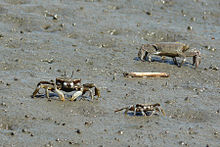| Macrophthalmidae | |
|---|---|
 | |
| Macrophthalmus japonicus | |
| Scientific classification | |
| Domain: | Eukaryota |
| Kingdom: | Animalia |
| Phylum: | Arthropoda |
| Class: | Malacostraca |
| Order: | Decapoda |
| Suborder: | Pleocyemata |
| Infraorder: | Brachyura |
| Superfamily: | Ocypodoidea |
| Family: | Macrophthalmidae Dana, 1851 |
This article relies largely or entirely on a single source .(January 2023) |
The Macrophthalmidae, commonly referred to as sentinel crabs, are a family of crabs, comprising these subfamilies and genera: [1]
- Ilyograpsinae Števčić, 2005
- Apograpsus Komai & Wada, 2008
- Ilyograpsus Barnard, 1955
- Macrophthalminae Dana, 1851
- Australoplax Barnes, 1966
- Enigmaplax Davie, 1993
- Hemiplax Heller, 1865
- Lutogemma Davie, 2008
- Macrophthalmus Desmarest, 1823
- Tasmanoplax Barnes, 1967
- Venitus Barnes, 1967
- Tritodynamiinae Števčić, 2005
- Tritodynamia Ortmann, 1894